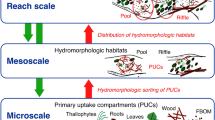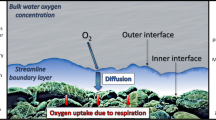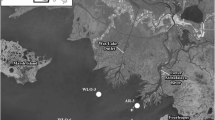Abstract
To quantify the contribution of hyporheic community respiration to whole running-water ecosystem respiration in a cultural landscape setting, we studied the vertical hydraulic exchange in riffle–pool sequences of the River Lahn (Germany). We used flow through curves from four tracer experiments to estimate flow velocities in the surface and subsurface water. Generally, vertical exchange velocities were higher in riffle sections and a high temporal variability was observed (range of values 0.11–1.08 m day−1). We then used (1) the exchange velocities and (2) time series of dissolved oxygen concentration in surface and subsurface water to calculate hyporheic respiration. Hyporheic respiration was estimated in a range of 10–50 mg O2 m−3 day−1 for the upper sediment layer (first 20 cm). It was much lower in the deeper sediment layer (20–40 cm), ranging from 0 to 10 mg O2 m−3 day−1 (volumes are volumes of interstitial water; the average porosity was 20%). We determined primary production and respiration of the biofilm growing on the sediment by modelling dissolved oxygen concentration time series for a 2,450 m long stream reach (dissolved oxygen concentrations with diurnal variations from 8 to 16 mg L−1). Modelled respiration rates ranged from 2 to 21 g O2 m2 day−1. All information was integrated in a system analysis with numerical simulations of respiration with and without sediments. Results indicated that hyporheic respiration accounted for 6 to 14% of whole ecosystem respiration. These values are much lower than in other whole system respiration studies on more oligotrophic river systems.








Similar content being viewed by others
References
Battin TJ, Kaplan LA, Newbold JD, Hendricks SP (2003) A mixing model analysis of stream solute dynamics and the contribution of a hyporheic zone to ecosystem function. Freshw Biol 48(6):995–1014
Bennett J, Rathbun RE (1972) Reaeration in open-channel flow. US Geological Survey Professional Paper, 737, US Government Printing Office, Washington, DC
Borchardt D, Fischer J (2000) Three-dimensional patterns and processes in the River Lahn (Germany): variability of abiotic and biotic conditions. Verhandlungen der Internationalen Vereinigung Limnologie 27:393–397
Borchardt D, Pusch M (eds) (2009a) The hyporheic zone of running waters: ecological patterns, processes and bottleneck functions. Fundam Appl Limnol Adv Limnol 61:168
Borchardt D, Pusch M (2009b) An integrative, interdisciplinary research approach for the identification of patterns, processes and bottleneck functions of the hyporheic zone of running waters. Fundam Appl Limnol Adv Limnol 61:1–8
Borchardt D, Reichert P (2001) River Water Quality Model no. 1 (RWQM1): case study I. Compartmentalisation approach applied to oxygen balances in the River Lahn (Germany). Water Sci Technol 43:41–49
Bretschko G, Klemens WE (1986) Quantitative methods and aspects in the study of the interstitial fauna in gravel streams. Stygologia 2:279–316
Brun R, Reichert P, Künsch HR (2001) Practical identifiability analysis of large environmental simulation models. Water Resour Res 37(4):1015–1030
Brunke M, Gonser J (1997) The ecological significance of the exchange processes between rivers and groundwater. Freshw Biol 37:1–33
Churchill MA, Elmore HL, Buckingham RA (1962) The prediction of stream reaeration rates. J Sanit Eng Div 88(SA4):1
Duff JH, Triska FJ (1990) Denitrification in sediments from the hyporheic zone adjacent to a small adjacent stream. Can J Fish Aquat Sci 47:1140–1147
Fellows CS, Valett HM, Dahm CN (2001) Whole-stream metabolism in two mountane streams: contribution of the hyporheic zone. Limnol Oceanogr 46:523–531
Grimm NB, Fisher SG (1984) Exchange between surface and subsurface water: implications for stream metabolism and nutrient cycling. Hydrobiologia 111:219–228
Ibisch RB, Borchardt D (2002) Effects of periphyton biomass and suspended solids on river bed permeability and hyporheic oxygen balances. Verhandlungen der Internationalen Vereinigung für Limnologie 28:1875–1879
Ibisch RB, Seydell I, Borchardt D (2009) Influence of periphyton biomass dynamics on biological colmation processes in the hyporheic zone of a gravel bed river (River Lahn, Germany). Fundam Appl Limnol Adv Limnol 61:87–104
Ingendahl D, Ter Haseborg E, Meier M, van der Most O, Steele H, Werner W (2002) Linking hyporheic community respiration and inorganic nitrogen transformations in the River Lahn (Germany). Archiv für Hydrobiologie 155:99–120
Ingendahl D, Ter Haseborg E, van der Most O, Werner W (2009) Hyporheic community respiration and nitrogen transformation as influenced by different interstitial flow velocities. Fundam Appl Limnol Adv Limnol 61:119–137
Jones JB (1995) Factors controlling hyporheic respiration in a desert stream. Freshw Biol 34:91–99
Lenk M, Saenger N (2000) Exchange processes in the river bed and their influence on temperature variations. Verhandlungen der Internationalen Vereinigung für Limnologie 27:427–430
McCuthan JH Jr, Lewis WM Jr, Saunders JF III (1998) Uncertainty in the estimation of stream metabolism from open-channel oxygen concentrations. J North Am Benthol Soc 17(2):155–164
Naegeli MW, Uehlinger U (1997) Contribution of the hyporheic zone to ecosystem metabolism in a prealpine gravel-bed river. J North Am Benthol Soc 16:794–804
O’Connor DJ, Dobbins WE (1958) Mechanism of reaeration in natural streams. Trans Am Soc Civ Eng 2934:641
Orghidan T (1959) Ein neuer Lebensraum des unterirdischen Wassers: Der hyporheische Biotop. Archiv für Hydrobiologie 55:392–414
Owens M, Edwards RW, Gibbs JW (1964) Some reaeration studies in streams. Int J Air Water Pollut 8:469
Pusch M (1996) The metabolism of organic matter in the hyporheic zone of a mountain stream, and its spatial distribution. Hydrobiologia 323:107–118
Reichert P (1994) AQUASIM—a tool for simulation and data analysis of aquatic systems. Water Sci Technol 30(2):21–30
Reichert P (1995) Design techniques of a computer program for the identification of processes and the simulation of water quality in aquatic systems. Environ Softw 10:199–210
Saenger N (2000) Identifikation von Austauschprozessen zwischen Fließgewässer und hyporheischer Zone. PhD dissertation, TU Darmstadt, Mitteilungen, 115
Saenger N, Zanke UCE (2009) A depth-oriented view of hydraulic exchange patterns between surface water and the hyporheic zone—analysis of field experiments. Fundam Appl Limnol Adv Limnol 61:9–27
Saenger N, Kitanidis PK, Street RL (2005) A numerical study of parameters controlling hyporheic exchange processes. Water Resour Res 41(12) W12424. doi:10.1029/2004WR003875
Schwoerbel J (1961) Über die Lebensbedingungen und die Besiedlung des hyporheischen Lebensraumes. Archiv für Hydrobiologie Supplement 25:182–214
Stanford JA, Ward JV (1988) The hyporheic habitat of river ecosystems. Nature 335:64–66
Stanford JA, Ward JV (1993) An ecosystem perspective of alluvial rivers: connectivity and the hyporheic corridor. J North Am Benthol Soc 12:48–60
Tsivoglou EC, Wallace JR (1972) Characterization of stream reaeration capacity, EPA-R3–72-012, US. Environmental Protection Agency, Washington, DC
Uehlinger U, Naegeli MW (1998) Ecosystem metabolism, disturbance, and stability in a prealpine gravel bed river. J North Am Benthol Soc 17:165–178
Vaux WG (1968) Intragravel flow and interchange of water in a streambed. Fish Bull 66:479–489
Wagner FH, Bretschko G (2002) Interstitial flow through preferential flow paths in the hyporheic zone of the Oberer Seebach, Austria. Aquat Sci 64:307–316
Wawra B, Saenger N, Montenegro H, Zanke UCE (2009) Driving forces for solute transport in the hyporheic zone of the River Lahn (Germany)—numerical simulations. Fundam Appl Limnol Adv Limnol 61:29–44
Acknowledgments
The authors thank the Organisation for Economic Co-operation and Development (OECD) for funding a research stay of D. Ingendahl at EAWAG and gratefully acknowledge the support provided by the German Research Foundation (Deutsche Forschungsgemeinschaft) to D. B., grant No. BO 1012/4-4.
Author information
Authors and Affiliations
Corresponding author
Rights and permissions
About this article
Cite this article
Ingendahl, D., Borchardt, D., Saenger, N. et al. Vertical hydraulic exchange and the contribution of hyporheic community respiration to whole ecosystem respiration in the River Lahn (Germany). Aquat. Sci. 71, 399–410 (2009). https://doi.org/10.1007/s00027-009-0116-0
Received:
Accepted:
Published:
Issue Date:
DOI: https://doi.org/10.1007/s00027-009-0116-0




